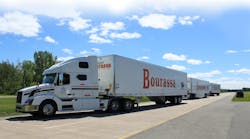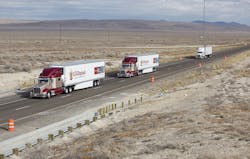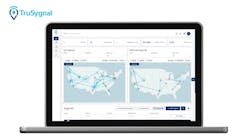When attempting to grasp the full measure of a technology’s promise, the best place to start may not be at the beginning. At times, greater insights may arise by starting in the future. Not in the future that begins tomorrow, but rather one envisioned in days gone past.
This seems to be the case when it comes to discerning how anticipated breakthroughs in the “‘HAL9000-ish” technology known as machine-to-machine communication (M2M) and its iterations will play out for the benefit of fleet owners and the motoring public as well as everyone concerned about greenhouse gas levels in the environment.
But first, there’s alphabet soup to digest. As was explained in FleetOwner back in 2009, M2M is defined as exchanging and leveraging data captured in different computer platforms and operating systems without requiring humans to take any direct action in the process.
Five years ago, trucking was perceived as an early adopter of M2M technology for rapidly embracing what telematics could deliver.
Now, telematics-based service-support solutions are offered by major truck OEMs. Other mile-markers of M2M’s growing influence on how trucking conducts its day-to-day business include the wide adoption of such communication-based solutions as location monitoring via GPS, geofencing controls, and the tracking of untethered-trailer activity.
Another way M2M technology has brought greater operational efficiency to truck fleets is through wider availability of satellite-based communication, typically selected by fleets as backup for when cellular-based networks are knocked down or simply out of range of a given highway route or work-truck operation.
An example of this is how satellite communications can support and widen the scope of fleet-management and asset-tracking systems, advises Tom MacLeod, director of data services for Iridium.
“With our global satellite network, we can extend telematics and M2M solutions to end users so they can capture the remote data they need and process it immediately,” MacLeod explains. “Many of these customers are not always able to access terrestrial cell-based data networks. They turn to a satellite-based network to plug the gaps when cellular coverage is spotty or nonexistent.”
He points out that “Iridium provides a radio-transceiver module to our channel partners, such as PeopleNet, so they can build satellite-based communications into the M2M devices they supply to end users.”
As MacLeod sees it, connectivity is essential to M2M capabilities. He says that “M2M is all about improving the productivity, safety and compliance of vehicles running on the road and operating in the field. All that can be accomplished by effectively monitoring and analyzing various parameters of vehicle operation through M2M-based solutions.”
“M2M came into trucking as telematics and is progressing from systems that know what the vehicle is doing and how it’s operating to ones that can look at what’s going on with the driver,” says Dan Valentine, director of marketing for NexTraq, a provider of GPS-based vehicle tracking and fleet management solutions.
“In that regard, the technology enables everything from providing swipeable ‘key fobs’ for assigning drivers to trucks to the capability to track all driver/vehicle status updates automatically once a truck has been dispatched,” he continues. “M2M even extends to leveraging data that exists outside the vehicle, such as for high-tech routing and accessing inventory in the supply chain.”
What’s more, Valentine says M2M communications can electronically and automatically link all the solutions mentioned and many others in a single fleet-management system. “Integrating systems via M2M is highly customizable,” he notes. “It all boils down to what the end user wants to look at and needs to see about their operation.”
As for his future take on M2M advances to come, Valentine says to “expect to see more mobile-based solutions that allow accessing the [management] system platform from anywhere there’s an Internet connection. Also, more and more solution functionality will be developed for fleet managers’ needs as well as to keep drivers better informed when out on the road.”
The widening impact of M2M technology is nothing less than a global phenomenon. But within the wide world of automotive-based transportation, M2M-based solutions are usually characterized specifically as providing either V2I (vehicle-to-infrastructure) or V2V (vehicle-to-vehicle) communications capabilities.
Fluent in V2I and V2V speak is Denny Mooney, Navistar International Corp.’s group vice president of global product development. Mooney joined the truck and engine builder a few years ago after retiring from General Motors. His background is in engineering. While at the auto giant, he held such positions as GM Engineering’s executive director for vehicle performance and GM vice president for global vehicle systems and integration.
“Simply stated,” says Mooney, “V2I technology is about accessing GPS and cellular/satellite communications to link vehicles on the move with physical structures they must interact with, everything from fleet headquarters to weigh stations. V2V refers to wirelessly connecting vehicles to each other.
“While V2I has been making inroads in trucking for a while, most notably as telematics, V2V gets into the realm of autonomous—driverless—vehicles, such as the one being developed by Google,” he continues.
Turning back to V2I, Mooney predicts the next evolution will entail leveraging data more effectively to improve vehicle uptime. “Right now, with our telematics solution OnCommand Connection, we can advise fleets on diagnostics and related maintenance or repairs needed and dealer service availability.
“But,” he continues, “V2I technology is headed to where more and more of the truck can be electronically controlled. For example, an automated manual would be remotely ‘directed’ when to most optimally shift on a grade to gain fuel economy. Or the cooling system and HVAC controls would interact and operate automatically for maximum efficiency. And we’ll see the remote, electronic recalibration of engines, and transmissions.”
Mooney predicts OEMs will start to roll out these and other similar V2I-based features on trucks within the next two to five years and that these upgrades will “quickly appear on many vehicles” given their cost-saving potential for fleets.
Futurama
Marc Weber, curator at the Computer History Museum in Mountain View, CA, writes in “Where to? A History of Autonomous Vehicles” that the basic dream of automated highways and driverless vehicles endures 75 years after Norman Bel Geddes’ vision of a road yet to come was revealed by General Motors way back at the 1939 New York World’s Fair.
A noted futurist, Bel Geddes designed GM’s dazzling “Futurama” display. The show exhibit modeled how—in just 20 or so years—the limited-access highway concept could be combined with electronic-speed, collision-control and vehicle-separation systems to ease highway access and increase speeds while improving safety. As for how all that might also improve fuel economy apparently crossed no one’s mind at the time.
“The idea was to drive to the freeway normally, then engage the automatic systems and kick back until your exit,” writes Weber. Often elements of such visions do pan out, albeit usually not as soon as they had once been so confidently predicted. And now trucking is poised to at last merge onto the highway of the future. That is to say one section of it, as this road is nowhere near complete. But that’s no matter, as no one can fully imagine what’s yet to come as M2M propels transportation innovation forward.
At least one U.S. firm is confident trucking will soon directly experience and immediately benefit from entering what once was but a stretch of the highway of tomorrow.
This V2V-paved entrance lane to the future is known simply as “vehicle platooning.” The concept is right out of the pages of vintage science fiction. Yet it is projected to pay real dividends to fleet owners as well as the truck drivers they employ and the motoring public with whom they share the road.
To platoon trucks is to efficiently operate them on a highway as closely coupled vehicles—one following after another at a preset distance—to form a road train.
Man and machine
This operational concept leverages electronic controls and the automatic processing of shared data via V2V systems to improve highway safety and reduce truck fuel consumption and thus greenhouse gas emissions. It also can ease the stress on truckers by easing their workload at the wheel.
In North America, Menlo Park, CA-based Peloton Technology is the firm walking point when it comes to truck platooning. It’s developing a system that uses radar-based collision mitigation equipment and V2V communication technology to enable the close-in platooning of two tractor-trailers. That’s two for now, anyway.
Josh Switkes, Ph.D., Peloton’s CEO, contends that implementing the one-two platooning of trucks by fleets where operationally feasible would improve highway safety by “electronically augmenting the skills of truck drivers.”
What’s more, he says platooning would greatly decrease fuel consumption, as aerodynamic drag is slashed whenever two trucks are closely and consistently aligned one after the other going down the road.
The brains of the Peloton system is V2V communication that enables the “following combination” to respond to the deceleration/braking of the lead rig in a mere few hundredths of a second. Switkes characterizes that response as coming “dramatically faster” than any human driver could react.
On the other hand, he says the Peloton system is not about replacing the driver, which is why the trucks’ operator always retains full control of steering. Switkes also points out that the various V2V and M2M systems interact to determine when platooning should be prevented because of poor weather or road conditions.
Also key to the Peloton system are video cameras. Switkes explains that these aim to “increase driver awareness [of the road and the vehicles around him or her] and assist the driver with keeping in lane and staying alert.” He notes that other onboard M2M-based gear, such as GPS and telematics systems, “interact with fleet operational tools to optimize the routing and thus the pairing of the trucks.”
Back in November, Peloton engaged the North American Council for Freight Efficiency (NACFE) as an independent third-party outfit to help plan, execute and validate an unbiased fuel-efficiency test of the truck-platooning system.
Mike Roeth, NACFE executive director, reports that rigs supplied by truckload carrier C.R. England were electronically “connected” to remain 36 ft. apart while operating at 64 mph on Interstate 80 west of Salt Lake City.
The platooned trucks were put through a modified SAE J1321 fuel-economy comparison test. The results, according to Roeth, showed a 10% fuel consumption reduction for the trailing tractor-trailer and a 4.5% reduction for the lead rig.
Truckers often take such painstaking real-world testing as proof of the pudding. Yet Switkes does point out that internal testing by Peloton of trucks platooned with less than 36 ft. of separation chalked up lower fuel consumption numbers than those scored in the controlled test.
Navistar’s Mooney contends that platooning may well prove out beyond the two-truck concept that is Peloton’s current focus. That is to say, why stop with a fleet here and there putting together platoons of two or (eventually, per speculation) a few of their own trucks?
Rather, he posits that “trucking could develop and agree on common communication protocols so trucks can virtually ‘meet’ on the road and then elect to platoon over a certain distance or route. Platooning technology is here; it’s the practical details and regulatory issues that have to be worked out.
Real as a pothole
Given that the Dept. of Energy has been supporting research and testing on this and that we at Navistar are involved in some projects,” Mooney adds, “I would expect to see truck platooning commercially available within 5 to 10 years.”
Yves Provencher, director of Performance Innovation Transport, a Montreal-based truck engineering/research nonprofit, remarks that while platooning may be just around the corner, for it to succeed “fleets will have to create the business model to implement it cost-effectively.”
Provencher urges fleet owners to “watch platooning closely, as it’s no longer science fiction. And once it arrives, the positive impact on safety and efficiency will compel government regulators to push for platooning’s adoption.”
Dreamed up now or in days past, a highway of the future is ultimately a mere vision. On the other hand, the progress wrought by M2M-based solutions is as real as a pothole in blacktop.
So, buckle up and enjoy the ride as M2M drives trucking ever forward—right onto a road smoothly paved by technology to run trucks more safely, more efficiently and more profitably.






